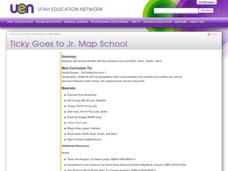Curated OER
What Do They Have In Common?
Fifth graders use a database to gather information on the United States last five Presidents. Using the information, they identify their similarities and differences and what characteristics made them a good leader. In further detail,...
Curated OER
You and the U.S. Constitution
Fourth graders explore the U.S. Constitution and how is protects the rights and freedoms of American citizens. They run through various circumstances and decide whether a person's rights have been violated.
Curated OER
Overland Trails To The West
Consider the political, physical, and geographical factors that led to and marked the Westward Expansion. Learners will track the various routes developed during the 1800's. They create a first person journal describing what they see,...
Curated OER
Greek Mythology in Art
Fifth graders recognize the specific mythological characters and their significance to Greek citizens, create representations of some gods and goddesses, and explore mythology as an attempt by earlier civilizations to explain natural...
Curated OER
My Flag for the Future
Students study the logo or crest that represents their hometown and describe what it means. They create a new logo for the younger members of their hometown after looking at images of symbols from many other cities and towns.
Curated OER
Ticky Goes to Jr. Map School
First graders sing "We All Live Together," by Greg and Steve. They look at a map and sing the "Soggy Waffle Song" to study about the compass rose. Students write N, E, S, W on the borders of paper that goes under a 100's chart. The...
Curated OER
What and Where is Puerto Rico?
Learners explore Puerto Rico. They create K-W-L charts of their prior knowledge of Puerto Rico and observe maps of Puerto Rico. They code the map for measurements and land and water forms. They explore websites to gain background on...
Curated OER
Da Vinci's Renaissance
Pupils study the Renaissance through an examination of the life and accomplishments of Leonardo Da Vinci.
Curated OER
A Survey of Ancient Religions
Students examine ancient religions of Confucianism and Buddhism. Pupils prepare a K-W-L chart, Venn Diagram and participate in think-pair-share activities. Classmates compare and contrast Confucianism and Buddhism. They explore the...
Curated OER
Quinceanera
Eighth graders study the Hispanic celebration known as the quinceanera. They research the quinceanera of two Hispanic cultures using print and digital resources. They compare the two celebrations and create a Power Point slide show to...
Curated OER
Local African News Stories
Students examine current event issues in Africa. In this global studies lesson, students select news articles from the provided website. Students make presentations on the news stories to their classmates.
Curated OER
Defining the American Dream
High schoolers define the American Dream and apply their knowledge of American history to evaluate the main idea of H.W. Brands' book, "The Age of Gold."
Curated OER
What And Where is Puerto Rico?: History of Puerto Rico
Students study the history of Puerto Rico. They define what a commonwealth is and how Puerto Rico became a commonwealth of the United States. They research websites for history of Puerto Rico and how it operates today. They complete...
Curated OER
Thinking About the World of Work
Students explore the laws and protections afforded to adolescent workers. They analyze two case studies, create KWL charts, participate in class discussions and write entries in a thinking log to record their reflections.
Channel Islands Film
Lone Woman of San Nicolas Island: Lesson Plan 3
Should researchers be able to excavate, examine, and remove Native American artifacts from historic sites? Should companies be permitted to build on sacred Native American land? After watching West of the West's documentary, The Lone...
Curated OER
Shasta Dam: How High is Too High?
Research water use in California, environmental protection laws, and the proposition to raise Shasta Dam by 200 feet. Researchers use their findings to build an argument which will be presented at a mock decision panel. Groups then...
Curated OER
Multiple Perspectives on the Korean War
Students interpret historical evidence presented in primary and secondary resources. For this Korean War lesson, students examine and analyze primary sources regarding U.S. involvement in the Korean War.
Curated OER
Soda Sales
Students are shown how to chart a supply demand curve, analyze information from a chart and send and receive information to participating schools by use of telecommunications (an added objective could be for fund-raising). They determine...
Curated OER
First Day Lesson Plan
Students participate in a first day icebreaker activity. In this icebreaker lesson, students are paired up and film their partner doing something unique. Students continue to film eachother while conducting a short interview.
Curated OER
The City I Live In
Research information about your city and state. Pupils investigate details such as the name of the city mayor, local establishments, and entertainment. For the state, they name the capital, governor, state flower, and flag. There are...
Core Knowledge Foundation
Christopher Columbus
Take some time to focus on Christopher Columbus, his three ships, the purpose of his voyage, and the new land he discovered. Pay special attention to the included additional materials, they are the real value in this resource.
Curated OER
The Greatest Educational Change America Has Ever Seen
Young scholars connect the symbols from the design of the United States Mint Fifty State Quarters Program to our country's history in this five-lesson unit. The culture, unique heritage, and geography of the individual states are probed.
Curated OER
I Am Special and You Are Special Too #5
The student create a drawing of themselves through the use of multicultural people color crayons. They explain to a teacher what makes them special. Students investigate family types, skin color, eye color, hair color, and favorites.
Curated OER
Build Illinois
Students examine the history of the formation of Illinois. Traveling virtually between time periods, they describe each period and compare them with how Illinois is now. They work together to complete an activity and worksheet.























